- Преподавателю
- Иностранные языки
- Научно-исследовательская работа учащегося в рамках НОУ «Myths and legends of Scandinavian and Slavic peoples»
Научно-исследовательская работа учащегося в рамках НОУ «Myths and legends of Scandinavian and Slavic peoples»
| Раздел | Иностранные языки |
| Класс | - |
| Тип | Другие методич. материалы |
| Автор | Романова Т.М. |
| Дата | 01.10.2015 |
| Формат | docx |
| Изображения | Есть |
GYMNASIJA № 7 NAMED AFTER V.M.VORONTSOV
SCHOOL RESEARCH PAPER
"MYTHS AND LEGENDS OF SCANDINAVIAN AND SLAVIC PEOPLES"
Prepared by Zheltikova Julia, 9В
Supervisor of studies Romanova T.M
Voronezh 2015
Contents
-
Entry………………………………………………………………….3
-
Myths and legends affecting different spheres of social life…………5
-
Myths and legends affecting poetry………………………………….7
-
Myths and legends affecting art:
Carving……………………………………..…………………………9
Embroidery……………………………………...……………………11
Storytelling…………………………………………………………...13
Jewelry……………………………………………………….……….13
-
Research work……………………………………………….….……20
-
Literature list………………………………………………….……....24
"History is something that happens, that is, crossing time, destroying it in contact with the eternal..."-
Jaspers Karl Theodor
Entry
Myths and legends are an integral part of any culture, which can help people to understand mentality and traditions of other representatives of humanity and to be more tolerant towards them. Of course, they are also an undeniable part of people's history, its' base, its' cradle, which never shall be forgotten.
Myths and legends' structure depend on different factors, such as:
• Environmental conditions - there cannot be legends about sea maidens or undines in African tribes just because there is not enough water even for people in some of them;
• Time of appearance - ancient myths are very different from the medieval ones because of many reasons: development of science, new discoveries in medicine, other mentalities, appearing of novel religions, etc.;
• People's customs in specified area - even cuisine can vary depending on traditions or region.
Certainly, myths and legends cannot be separated from the religion: they are intertwined with each other in such a tough way, so sometimes it is hard to say, where the legend finishes and the religion starts.
In this work I want to compare the legends and religions of Slavic and Scandinavian peoples to see, how different or similar they can be.
As a matter of fact, these two peoples are quite close to each other in geographical, cultural and historical way: the above mentioned peoples have appeared in the era of collapse of the primitive communal system and the formation of feudal society and early medieval states. This was the era of the birth and activity of new social forces, tearing the narrow confines of primitive tribal groups and accumulating in social associations - early urban trade and handicraft centers, military guards, merchants and craft organizations. The general thrust of social processes required close relationship of new forms of social organization, which was clearly reflected in the economy and culture.
Discoveries of recent decades, such as the study of numerous Slavic early medieval monuments on the southern coast of the Baltic Sea, in what is now the German Democratic Republic and the Polish Pomerania, the study of Slavic cities, medieval predecessors of Hansa - Volin, Szczecin, Gdansk, Lübeck and other monumental excavations of ancient Rus Novgorod; systematic researches in the northern "vikah" Scandinavian trade and craft centers, which did not survive the rough and bright "Viking Age" (IX-XI centuries), primarily Birka in Sweden and Hedeby in Denmark; excavations of early-state "royal fortress" and ordinary rural settlements, pagan cemeteries and shrines, craft workshops and port facilities have provided very high quality and new material against which a new meaning and a textbook, long known to science monuments has been taken: the famous "royal burial mounds" with Norman burials in ships, treasures of gold and silver and works of Old Norse art.
Generalization of these findings, comparing them with the data of written sources - chronicles, the heroic legends and sagas - represent a problem, on the solution of which scientists are working in different countries and scientific organizations in Northern Europe. Research centers are the Academy of Sciences of the USSR, Poland and the GDR, Research Center and Museum in Kiel in Schleswig (Germany), the National Museum in Copenhagen and the National Museum in Aarhus (Denmark), the Historical Museum in Stockholm (Sweden), the National Museum in Helsinki (Finland) and many university departments, museums and research institutions.
Features of the present stage of the study of culture of the Baltic states are in urgent need to move from local studies to create the fullest possible picture of historical relationships of peoples and cultures of the Baltic states in the eventful, bright, though distant period, which begins the history of modern states and peoples of the Baltic region.
Myths and religion affecting different spheres of social life.
Works of art and culture, which have come down to us from the distant era of Vikings, are distinguished by a deep and close relationship between the functional form of the object (whether it is a weapon's clasp or clothes brooch, buckle detail of horse harness, tool or household item, up to the dining room and kitchen dishes), and it's rich decorations, which had reflected the specific features of people's thinking and worldview at that time. Rationalistic ideas about the nature, production processes and public relations had intertwined, and sometimes merged with fantastic views, in which the world, the fate of the people and things were ruled by terrible, powerful and diverse forces.
Mythology and pagan beliefs of people of the Baltic Sea region is not fully come down to us. In essence, these views are not very different in various tribes; deities and other sacred forces of Slavs and Scandinavians, Balts and Finns are quite comparable.
Individual tribes have had their great gods who sometimes have formed even the whole family.
Scandinavians' Odin was the father and leader of the Aces. He is a sage and shaman, a connoisseur of runes and tales (sagas), the king-priest, prince (konung)-magus, but at the same time, the god of war and victory, the patron of the military aristocracy, the owner and master of Valhall and Valkyries' lord. According to the myths, on the day of Ragnarok he will be killed by the monstrous wolf Fenrir. Freya was his divine wife, an embodiment of fertility.
In some West Slavic tribes Sventovit played the same role: Odin and Sventovit were riders, who had a squad and demanded the bloody sacrifices. Odin drove an octopus stallion Sleipnihr, and for Sventovit priests took care of the wonderful white horse in the hoofprints of which the will of God can be read.
Scandinavians' Thor was a great Thunderer, symbolized by the hammer Mjölnir (the lightning). "Thor hammers" are common in variety among jewelry made of gold, silver, bronze, iron or amber.
Eastern Slavs and Balts matched Perun (Perkūnas) The Great Thunderer to Scandinavians' Thor. Wiltz-Lutici revered Svarozhich, the sun god, patron of blacksmiths and fire.
In the Uppsala temple next to the image of Odin and Thor stood the idol of Freyr. His character as a god of fertility was fallos.
In some places, such as Hafelsberg and Wolgast, Slavs worshiped the god in the form of a spear, Gerevit. Both the eastern and western Slavs had a cult of the god of cattle and wealth - Volos (Veles).
Images of gods embodied in idols made in human growth and even more, but along with it, small figures existed too. These "portable" gods, often carved out of wood, are known among the Germans and Slavs; perhaps they date back to the bronze statuette, appeared in the first centuries of our era. Related, apparently, to the cult of ancestors, these early bronze images for some formal features can be associated with similar miniature sculptures of the Romans. From the first century A.D. this type of images appeared in the Baltic region, where they are modified, and finally become an integral part of the local artistic imagery.
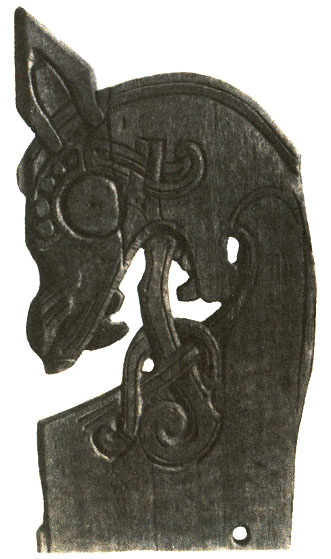

-
Carved ship decoration from Gokstad, Norway, IX century.
-
Silver pendant treasure, X century, found in 1868 in the cluster near Smolensk.
This was a piece of generalized information and now I'm going to observe it in more details.
Myths and religion affecting poetry.
As I am a kind of a poet and poetry venerator, the first item I will speak about more amply is Scandinavian poetry, which was affected by myths, legends and pagan beliefs.
The fundamental phenomenon of Scandinavian folk literature is the elder Edda, the sung Edda - a collection of songs about Old Norse gods and heroes of Norse mythology and stories. Legends' authorship attributes to the Icelandic scientists Sæmundr fróði. However, there is no doubt that the songs arose much earlier in the course of centuries passed on in the oral tradition. Some of them date back to the South German prototypes. Evidence of their archaic is that the songs are not deployed in a wide epic, as in case with the works of Anglo-Saxon and Germanic epic. No doubt that we heard not all the songs, and the one that have been preserved have appeared in different periods of history, and later some of them have experienced the Christian influence.
"Elder Edda" is one of the forms of the ancient epic. The songs outline the fate of gods and heroes, their words and deeds. In terms of genre songs are divinations, sayings, mythological actions and pure narratives. Some of these stories are repeating each other, or refer to the items that are being developed in other songs. Therefore, the isolated reading of one of them is sometimes difficult to be understood by the modern reader. Meanwhile, the language of the "Edda" is more simple than fancy.
English translators are not consistent on the translations of the names of the Eddic poems or on how the Old Norse forms should be rendered in English.
Mythological Poems.
Songs about the gods:
-
Völuspá (Wise-woman's prophecy, The Prophecy of the Seeress, The Seeress's Prophecy);
-
Hávamál (The Ballad of the High One, The Sayings of Hár, Sayings of the High One);
-
Vafþrúðnismál (The Ballad of Vafthrúdnir, The Lay of Vafthrúdnir, Vafthrúdnir's Sayings);
-
Grímnismál (The Ballad of Grímnir, The Lay of Grímnir, Grímnir's Sayings);
-
Skírnismál (The Ballad of Skírnir, The Lay of Skírnir, Skírnir's Journey);
-
Hárbarðsljóð (The Poem of Hárbard, The Lay of Hárbard, Hárbard's Song);
-
Hymiskviða (The Lay of Hymir, Hymir's Poem);
-
Lokasenna (Loki's Wrangling, The Flyting of Loki, Loki's Quarrel);
-
Þrymskviða (The Lay of Thrym, Thrym's Poem);
-
Völundarkviða (The Lay of Völund);
-
Alvíssmál (The Ballad of Alvís, The Lay of Alvís, All-Wise's Sayings);
Eddic songs:
-
Baldrs draumar (Baldr's Dreams);
-
Gróttasöngr (The Mill's Song, The Song of Grotti);
-
Rígsþula (The Song of Ríg, The Lay of Ríg, The List of Ríg);
-
Hyndluljóð (The Poem of Hyndla, The Lay of Hyndla, The Song of Hyndla);
• Völuspá in skamma (The short Völuspá, The Short Seeress' Prophecy, Short Prophecy of the Seeress);
• Svipdagsmál (The Ballad of Svipdag, The Lay of Svipdag);
• Grógaldr (Gróa's Spell, The Spell of Gróa);
• Fjölsvinnsmál (Ballad of Fjölsvid, The Lay of Fjölsvid);
-
Hrafnagaldr Óðins (Odins's Raven Song, Odin's Raven Chant).
Slavic analogue of Edda.
Informal, or historically not proven Slavic Edda analogue is the Veles book. It is a falsification written in the XIX or (more likely) XX century which primitively imitates Proto-Slavic language. Veles Book's text was first published in 1950 by Russian emigrants Mirolyubov and Kurenkov in San Francisco. The most likely author of the falsification is considered to be Myrolyubov. According the author, Veles book was written off from woodblocks created around the IX century which were lost during the war and supposedly contain stories, prayers, legends and stories about ancient Slavic history from about VII century BC. to the IX century BC.
Most researchers - both historians and linguists - are convinced in the spuriousness of the Veles book and do not consider it as a reliable source, so I won't speak about it any longer.
Myths and legends affecting art.
Both Slavs and Scandinavians had a complicated art which had a big religious influence. Though we're speaking about Viking era, the word "art" means carving, stone carving, embroidery, storytelling and primitive by modern standards, but filigree enough for those times jewelry art .
Carving.
Scandinavians.
Carvers and stone carvers worked on temples, idols and other religious objects. The greatest example of Scandinavian cavers' work is the Urnes Church.
Urnes Stave Church, Norway is the oldest surviving kirk, built in about 1130. It is a World Heritage Site by UNESCO.
The church is known by carved panels which are preserved from 1050, demonstrating urness last flowering species of widespread in Scandinavia "animalistic style".
The characteristic feature of this style is asymmetric and undulating ornament. It is not immediately possible to catch the main story - like creature is not the lion, not the dog, entangled serpents on reindeer legs. There are many theories about the plot, which the author wanted to portray with this urness thread.
Perhaps, as on some runic stones, Panel shows one of the battles of "Twilight of the Gods" - Ragnarok, opposition of serpent Jörmungand and reincarnated god of thunder and lightning Thor. Another interpretation of relief is based on Norse mythology. Some see him as a deer, gnawing the roots of the World Ash Yggdrasil. Probably, the closest to the truth hypothesis is recognizable Christian symbol in the battle of lion (Christianity) with the dragon (paganism).
There were analogies to this style in Russia in the XV century, but there it did not take root, and soon died.
Portal in Urnes Church cannot fully be called portal. It's more of an artistic frame of the doorway, made in the form of the runic stone.
Church in Urnes is the only well-preserved monument that can give an idea of how architecture could look like in pre-Christian Scandinavia. The nature of the execution of some woodworks suggests that originally the art was focused on the work of metal or stone.
Meeting with urness style outside the context of this monument can be in the case of the study of jewelry pieces and runic stones. Runic stones may be attributed to the small forms of architecture, where the artist had certain compositional tasks associated primarily with the closed form.
Decoration of facades confronted artists to the problem of a new character, which was successfully accomplished. It seems that the Urnes carvers could not refuse from the former artistic device and pasted runic stone in the wall of the building, surrounding it with additional ornament fields.
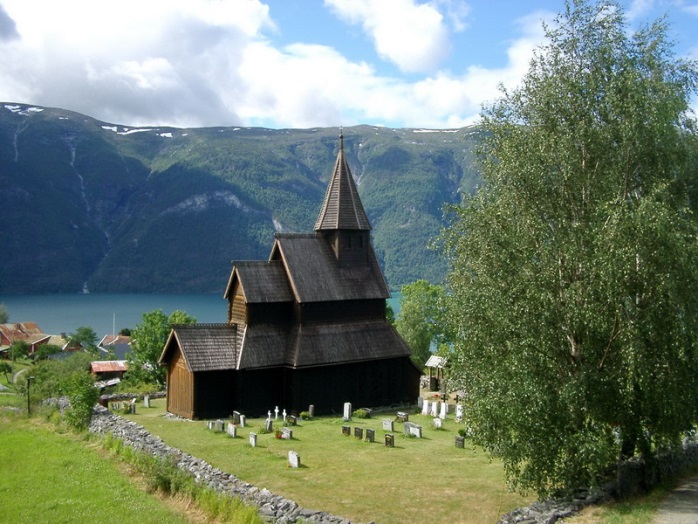
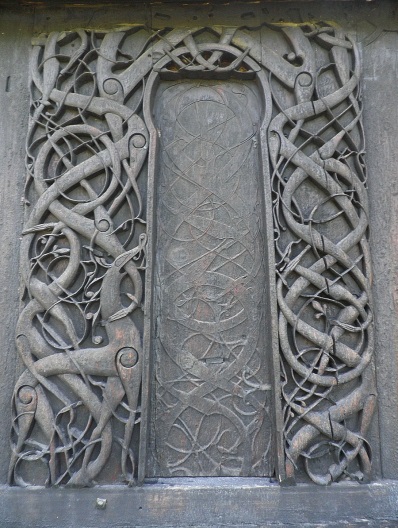
-
Urnes stave church.
-
Carved portal of the church.
Slavs.
Craft of woodcarving applied and in Russ too. Unfortunately, only a few samples of Slavic works reached our time. This happened because of their low cost and frailness of their composing material.
Carvers and ordinary people produced figures of animals, birds, various amulets, which are handed down from generation to generation. People of that time believed that the tree is the link between the sun and a man.
But very often the wooden products were purely practical or were cult objects used by the whole family.
Wood carving decorated furniture, dishes, toys and other products because at that time the tree was very screwed material. Wood carving was widely used in wooden architecture of that time, giving us a lot of architectural monuments. Masters of wood carving in ancient Russ possessed vast knowledge in the field of art, a great sense of beauty and a rich imagination. All of this allowed them to create true works of art both among the wooden toys and among the architectural structures.
The proofs are artifacts found in Novgorod during archaeological excavations. A fragment of a wooden column which modern scientists date by the XI century AD is the most interesting among them. It is decorated by pattern over its entire length, but this pattern is not repeated throughout it.
Pattern lines are boldly curved in all the directions, the equilibrium is disturbed consciously, the general shapes are bizarre. These are characteristic signs of Novgorod style in the applied arts.
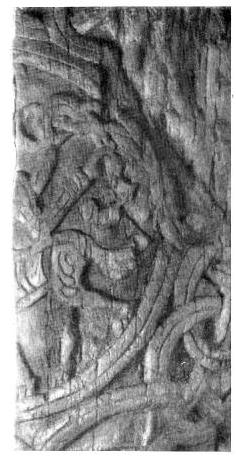
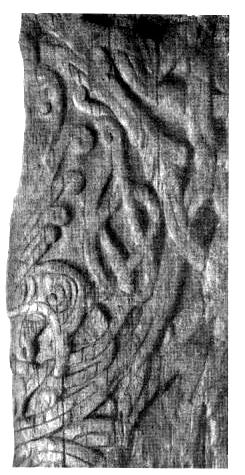
-
The column (upper stamp). Image of griffin.
-
The column (lower stamp). Image of centaur.
Embroidery
Scandinavians.
In the south-western Norway there is a Hardanger town which gave the name to the embroidery fabric and style itself. Hardanger is traditionally embroidered with linen or cotton thread of pastel colors on the rough canvas of similar color. However, currently there are no such restrictions, and each needlewoman selects a color palette, fabric or yarn. Initially, patterns on aprons in the Norwegian national costume were embroidered in the Hardanger style but in the XIX century this embroidery decorated home textiles.
It is believed that the ancestor of Hardanger embroidery was originated in Persia. From Persia it penetrated into Europe.
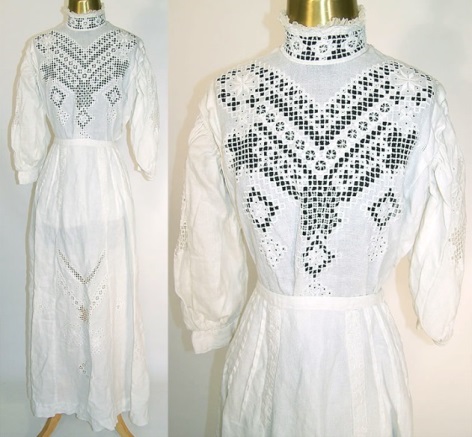
-
Hardanger embroidery in Scandinavian national costume.
Slavs.
Slavic embroidery is a kind of arts and crafts of the Slavs, comprising in applying an ornament on the fabric using sewing. It usually decorated shirts, tablecloths and towels. Characteristic color is red pattern on white canvas. Originally embroidery was like a magic talisman. It decorated the parts of the suit, through which, on presentation of our ancestors, the evil forces could penetrate the human body. Hence, the basic meaning of embroidery in ancient times - protective. Protective pattern was embroidered on gates, cuffs, hem and neck incision.
Embroidered subjects were diamonds, broken and straight lines, dots and crosses. In addition to these abstract images often associated with the sun, earth, water and grain, the motives of embroidery included schematics of flowers, trees, birds, horses, dogs and Alcon.
Stitches that compose vintage embroidery are countable. That means that for each considered stitch fabric yarns are counted. Preliminarily pattern is not translated on the fabric, but only can be targeted with large stitches on its place.

-
Slavic embroidery in Slavic national costume.
Storytelling.
Scandinavians.
The most distinctive genre of Old Norse literature is clan saga. Prose clan sagas that are associated with oral folk tradition are no less important than the poetic epic. Saga writing began in the second half of the XII and especially XIII century. Historical basis that sagas reflected is the real life events of Scandinavians since the end of IX century. The main content of the clan saga is the family history in the person of its most prominent representatives. Character of the clan saga is always a real historical person. The main place in the clan sagas hold inter-clan feuds, accompanied by killings, burning of houses with the inhabitants, litigation, fights, expulsions, and so on. They also report detailed information on kinship, marriage, inheritance and ownership, but the creative reality reworking also existed.
Narration in clan sagas is extremely lively: dialogue takes a very big place. The narrator is objective, he does not approve, abuse, or explain. His tone is reticent, his characteristics are deeply realistic. Despite the reality of the image, tribal superstition abounds saga. However, these superstitions do not violate the general credibility of the story. No wonder that sagas were the favorite reading of Icelanders. The most popular sagas are "The Saga of Nyala," "Egil's Saga," "The Saga of Gunnlaug." Writers of clan sagas are unknown.
Slavs.
On the basis of paganism Slavs formed a rich heritage - songs, spells, incantations, folk tales, proverbs, riddles and stories. Old Russ epic reflects the spiritual values of the people, their traditions, features of life, real events and historical figures. It is considered that epic Prince Vladimir The Red Sun had his prototype - Vladimir the I Svyatoslavovich and hero Dobrynya - his uncle - Boyar Dobrynya.
Jewelry.
Scandinavians.
Scandinavians were good farmers, soldiers, artisans, merchants and worshiped cruel gods. All this is reflected in their traditional jewelry.
Scandinavians' religion was one of the strongest movers which helped with battles and conquests of new lands. Of course, it also influenced the design of jewelry. Such products are considered to be protective and sacred.
Odin was considered the main deity. He was called the "father" and depicted as two ravens - Hugin and Munin - or wolf. This symbolized memory (Munin) and thinking (Hugin), as he gave one of his eyes to drink from the fountain of wisdom.

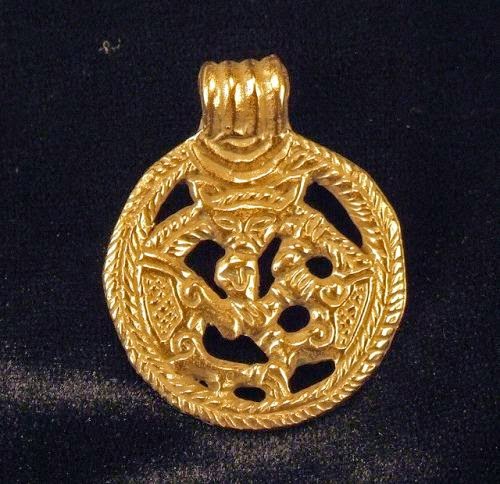
-
Two ravens symbolizing Odin.
-
Wolf symbolizing Odin.
Items like a horn and a bridge are often found in Scandinavian jewelry. It is connected with the guarding god Heimdall. According to legends, he was the spirit of connecting the body and soul, he guarded the Bifröst bridge which guided towards the gods. He had a horn in his hands which, according to legend, announces Ragnarök.
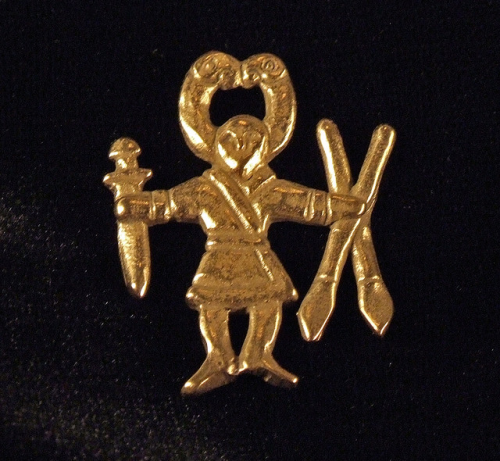
-
Heimdall.
The symbol which is found in Scandinavians' jewelry quite often is the Thor's hammer (Mjolnir).
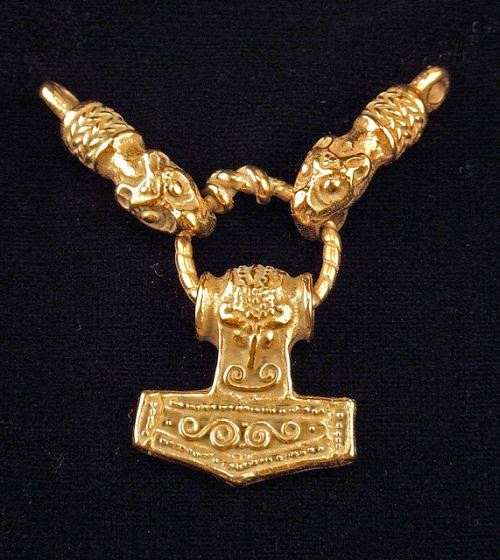
-
Mjolnnir.
The fertility goddess Freya was depicted with a special necklace - Brisingamen. It promised luck in love and granted beauty. The symbol of the goddess is the falcon. She patronized prosperous fertility and soil fertility.
Freya had the brother Freyr, who was depicted as a golden boar. He was also the god of fertility and brought success in business.
The most common symbols met in Scandinavian jewelry are the World Ash Yggdrasil, runes, pictures of animals and Celtic symbols (because of close contact with the Celts).
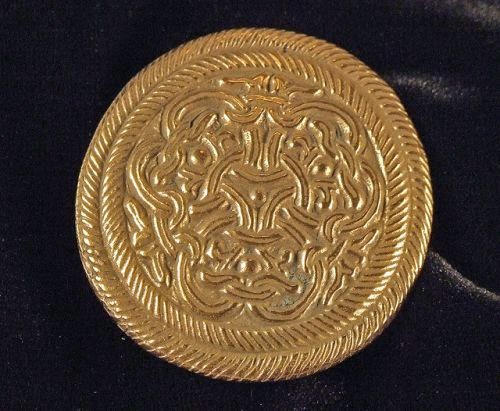
-
The World Ash Yggdrasil.
Warriors wore screwed bracelets that they received for winning the battle or carrying out a successful raid.
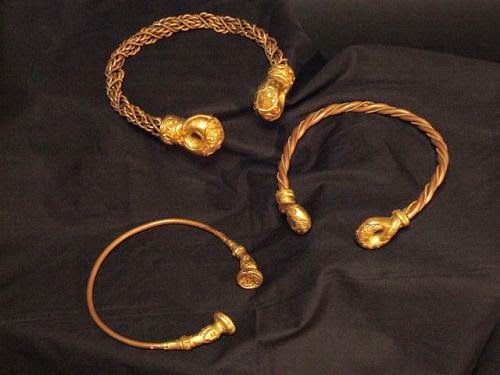
-
Warriors' screwed bracelets.
Some Scandinavians, especially those who lived in the territory of modern Denmark, found on the seashore amber and inlaid it in their jewelry.
Slavs.
Ancient Russ' jewelry crafting has a long history. It is rooted in the peasant way of life, a life of ancient Slavic settlements. It is interesting to note that the first jewelers were women. Among the large number of works on the arrangement and decoration of life, they are also manufactured jewelry and amulets.
It is curious that each tribe brought in the same jewelry something of its own, characteristic only for this area. Illustrative examples are the kolts - temporal jewelry that women weaved into the hair or attached to headdress.
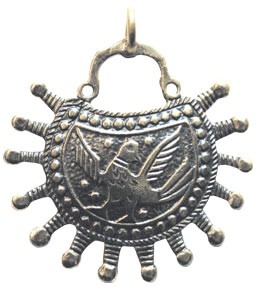
-
Slavic kolt.
For example, kolts in the form of seven-rayed stars are typical for Radimichi and Vyatichi - rays are extended to the end, in Novgorod - expansion in a diamond, the northerners - spiral, etc. Later kolts began to be made hollow, most likely, it was possible to put a cloth impregnated with fragrances inside.

-
Vyatkian seven-rayed kolt.
Jewelers, or rather, at that time - silver and goldsmiths - met and mastered new techniques and patterns coming from the east and the north. However, the master's own style was always conserved, successfully integrating new knowledge and traditions, they produced unique crowns and tiaras, bartenders, kolts, hryvnias, bracelets, buckles, crosses and many more other fascinating items.
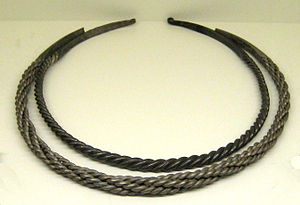
-
Slavic hryvnia.
The greatest flowering of the jeweler's art was reached in Russ in XII - XIII centuries. Masters owned lots of jewelry techniques. A grain technique was widely used. It is soldering of sets - thousands - of tiny metal beads on a product that creates a wonderful play of light. The filigree technique is that the pattern is laid or twisted with golden wires, flattened using a hammer, or gold wire.
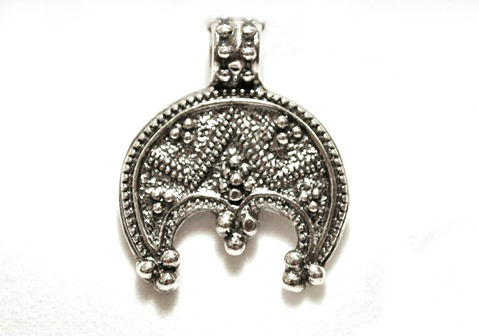
-
Slavic women's amulet - "lunnitsa" - crafted in grain technique.
However, the most well-known techniques of that time were enamels, they were used for decoration of gold and silver, as well as for books' registration. Enamels were of two kinds - notched and partitioned. The last are considered to be the top of jewelry art of Kievan Russ.
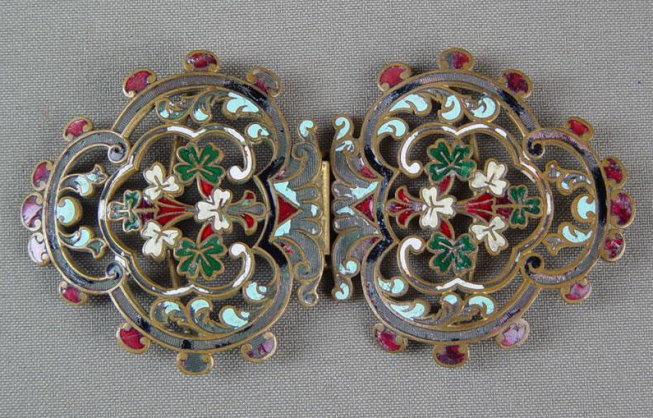
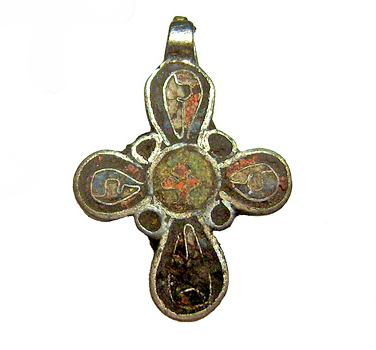
-
Slavic clasp with notched enamel.
-
Slavic cross (after baptism of Rus) with partitioned enamel.
All the craftsmen's of that time skill can be estimated if cite as an example some numerals. In the Russian Museum in St. Petersburg there are silver kolts in the form of a semi-circular plate with six silver cones. Each cone has 5,000 tiny ringlets, and on each ringlet are soldered silver grains. That means that only one kolt has 30,000 grains of silver soldered on it!
Research work.
On the basis of the above written text I can make the following conclusion: certainly, Slavic and Scandinavian peoples are unique, but they have much in common because of their geographical closeness, the approximate similarity of mentalities and similar pagan religions' influence.
However, forgetting the Scandinavian peoples, I wonder how many of the modern Russian citizens know about primordial traditions and customs of their ancestors that existed before the Rus Baptism?
To answer my question, I conducted several studies, the results of which are shown below.
▪ The first study was on the topic of paganism. I asked people on the streets of the city, in my school and in home if they can name the first religion appeared in Slavic tribes.
There were four options to answer this question:
• Paganism;
• Christianity;
• Atheism;
• It is hard to answer.
The result is:
11 of 20 people said that the first Slavic religion was paganism, what is absolutely correct;
5 of interviewed people said it was Christianity, what is at least wrong;
2 people chose atheism, what is weird;
The rest 2 people found it hard to answer this question, or just did not want to.
-
Diagram of the results of my first study.
▪ In the second study I wanted to see the attitude to paganism, so I asked different categories of people - adults, teenagers and senior citizens - about their reaction.
So, this study included a question, which had four options to answer:
-
What do you think of paganism?
• I treat it negatively, it is idolatry and contrary to the precepts of Christianity, it is a sin;
• I am neutral, I do not care about this religion/all religions at all;
• I approve this, I'm a Pagan;
• It is hard to answer.
-
Diagram for teenagers' answers.
-
Diagram for adults' answers.
-
Diagram for senior citizens' answers.
So, as we can see on the diagrams, 4 out of 10 interviewed teenagers treated paganism negatively, which was really surprisingly to me, 2 were neutral, 1 approved it and 3 found it hard to answer, whereas in the adults' group already 5 people ranked paganism as sin, 3 were neutral, 1 considered to be the pagan - what a suddenness! - and 1 refrained from the answer. But the less tolerant to paganism group were senior citizens: 8 of them treated this religion negatively, 1 was neutral, no one was Pagan and 1 did not answer.
According to the results I can make a conclusion: most people forget that paganism was the first Slavic religion, and even those who remember rate it as a sin.
Well, in my opinion, results could be better, but in general they are quite normal, except older generations' sharp rejection of their people's ancestral traditions which had disappeared in the result of historical events.
Literature list
All the information was found on the unnamed Internet sources or known previously.
19


